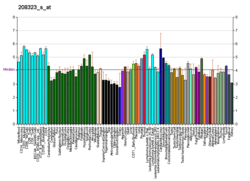Annexin A13
Annexin A13 is a protein that in humans is encoded by the ANXA13 gene.[4][5]
Function
This gene encodes a member of the annexin family. Members of this calcium-dependent phospholipid-binding protein family play a role in the regulation of cellular growth and in signal transduction pathways. The specific function of this gene has not yet been determined; however, it is associated with the plasma membranes of undifferentiated, proliferating endothelial cells and differentiated villus enterocytes. Alternatively spliced transcript variants encoding different isoforms have been identified.[5]
gollark: Besides, you would need a moderately large amount of ender chests to succeed.
gollark: It's entirely secure, as it's against the rules and thus impossible to steal from it, and it's cheaper.
gollark: Or some derivative.
gollark: You should* support EnderMail!
gollark: Bzzzzz bzzzz bees have been dispatched to correct your utter folly.
References
- GRCh38: Ensembl release 89: ENSG00000104537 - Ensembl, May 2017
- "Human PubMed Reference:". National Center for Biotechnology Information, U.S. National Library of Medicine.
- "Mouse PubMed Reference:". National Center for Biotechnology Information, U.S. National Library of Medicine.
- Morgan RO, Bell DW, Testa JR, Fernandez MP (Feb 1998). "Genomic locations of ANX11 and ANX13 and the evolutionary genetics of human annexins". Genomics. 48 (1): 100–10. doi:10.1006/geno.1997.5148. PMID 9503022.
- "Entrez Gene: ANXA13 annexin A13".
External links
- Human ANXA13 genome location and ANXA13 gene details page in the UCSC Genome Browser.
Further reading
- Wice BM, Gordon JI (Jan 1992). "A strategy for isolation of cDNAs encoding proteins affecting human intestinal epithelial cell growth and differentiation: characterization of a novel gut-specific N-myristoylated annexin". The Journal of Cell Biology. 116 (2): 405–22. doi:10.1083/jcb.116.2.405. PMC 2289284. PMID 1530946.
- Maruyama K, Sugano S (Jan 1994). "Oligo-capping: a simple method to replace the cap structure of eukaryotic mRNAs with oligoribonucleotides". Gene. 138 (1–2): 171–4. doi:10.1016/0378-1119(94)90802-8. PMID 8125298.
- Suzuki Y, Yoshitomo-Nakagawa K, Maruyama K, Suyama A, Sugano S (Oct 1997). "Construction and characterization of a full length-enriched and a 5'-end-enriched cDNA library". Gene. 200 (1–2): 149–56. doi:10.1016/S0378-1119(97)00411-3. PMID 9373149.
- Dias Neto E, Correa RG, Verjovski-Almeida S, Briones MR, Nagai MA, da Silva W, Zago MA, Bordin S, Costa FF, Goldman GH, Carvalho AF, Matsukuma A, Baia GS, Simpson DH, Brunstein A, de Oliveira PS, Bucher P, Jongeneel CV, O'Hare MJ, Soares F, Brentani RR, Reis LF, de Souza SJ, Simpson AJ (Mar 2000). "Shotgun sequencing of the human transcriptome with ORF expressed sequence tags". Proceedings of the National Academy of Sciences of the United States of America. 97 (7): 3491–6. doi:10.1073/pnas.97.7.3491. PMC 16267. PMID 10737800.
- Plant PJ, Lafont F, Lecat S, Verkade P, Simons K, Rotin D (Jun 2000). "Apical membrane targeting of Nedd4 is mediated by an association of its C2 domain with annexin XIIIb". The Journal of Cell Biology. 149 (7): 1473–84. doi:10.1083/jcb.149.7.1473. PMC 2175132. PMID 10871286.
- Noda Y, Okada Y, Saito N, Setou M, Xu Y, Zhang Z, Hirokawa N (Oct 2001). "KIFC3, a microtubule minus end-directed motor for the apical transport of annexin XIIIb-associated Triton-insoluble membranes". The Journal of Cell Biology. 155 (1): 77–88. doi:10.1083/jcb.200108042. PMC 2150803. PMID 11581287.
- Iglesias JM, Morgan RO, Jenkins NA, Copeland NG, Gilbert DJ, Fernandez MP (May 2002). "Comparative genetics and evolution of annexin A13 as the founder gene of vertebrate annexins". Molecular Biology and Evolution. 19 (5): 608–18. doi:10.1093/oxfordjournals.molbev.a004120. PMID 11961095.
- Anderson NL, Polanski M, Pieper R, Gatlin T, Tirumalai RS, Conrads TP, Veenstra TD, Adkins JN, Pounds JG, Fagan R, Lobley A (Apr 2004). "The human plasma proteome: a nonredundant list developed by combination of four separate sources". Molecular & Cellular Proteomics. 3 (4): 311–26. doi:10.1074/mcp.M300127-MCP200. PMID 14718574.
This article is issued from Wikipedia. The text is licensed under Creative Commons - Attribution - Sharealike. Additional terms may apply for the media files.


